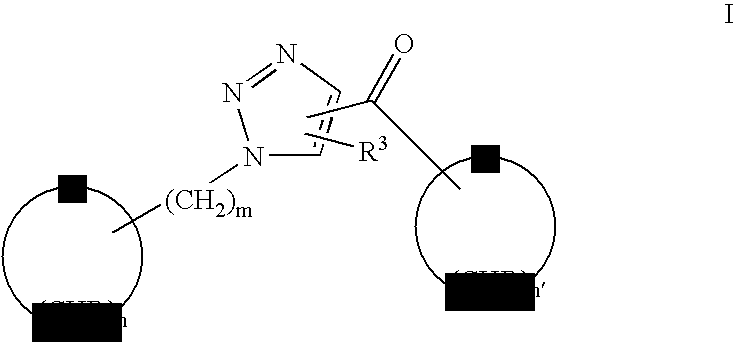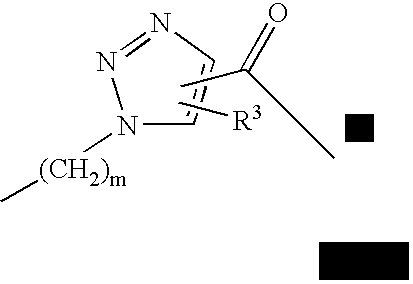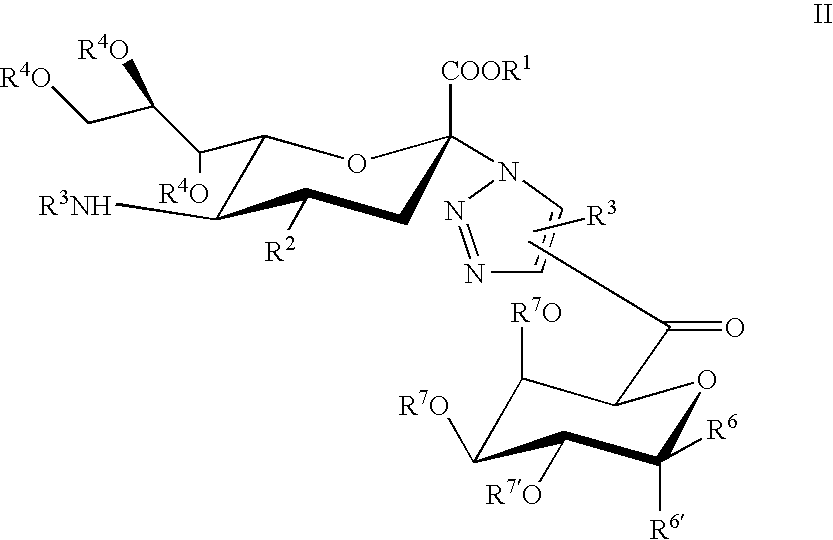Triazole linked carbohydrates
a carbohydrate and triazole technology, applied in the field of triazole linked carbohydrates, can solve the problems of difficult chemical construction of ether oxygen linkage, many harmful biological reactions of ligands, and difficulty in using carbohydrate structures as pharmaceuticals,
- Summary
- Abstract
- Description
- Claims
- Application Information
AI Technical Summary
Problems solved by technology
Method used
Image
Examples
example 1
Cycloaddition from the Azide 31 and the Acetylene 14 to Give Products 32a & 32b (Structures Shown in FIG. 5)
Azide 31 (112 mg, 0.39 mmol) and the acetylene 14 (112 mg, 0.40 mmol) in toluene (1 ml) was heated to 110.degree. C. for 20 h. The reaction mixture was cooled and the major product was isolated by chromatography on a column of silica gel using etyl acetate-hexane as eluant. After elution of the minor product 32a, the major component 32b eluted out. The weight of 32b was 161 mg. .sup.1 H-NMR (CDCl.sub.3): 32a: 8.32 (s), 5.68 (d, H-1), 5.43 (d, H-1'a), 4.91 (d, H-1'b), 4.67 (m, H-3), 4.66 (m, H-4), 4.63 (m, H-2), 4.59 (broad s, H-5), 4.47 (d, H-3'), 4.37 (d, H-5'), 4.18 (broad d, H-4'), 3.88 and 3.76 (dd, H-6a and H-6b), 1.6-1.2 and 0.57 (8.times.s, isopropylidene methyls). .sup.1 H-NMR (CDCl.sub.3): 32b: 8.36 (s), 5.75 (d, H-1), 5.37 (d), 5.04 (dd), 4.73 (d, H-1'a), 4.71-4.64 (m, H-3 and H-4), 4.60 (d, H-1'b), 4.43 (m, H-2), 4.41 (d, H-5), 4.23 (dd, H-5'), 3.87 and 3.76 (d, H-6...
example 2
Cycloaddition from the Azide 27 and the Acetylene 14 to Give Product 33 (Structure Shown in FIG. 5)
Azide 26 (205 mg, 0.40 mmol) and the acetylene 14 (112 mg, 0.40 mmol) in toluene (1 ml) was heated to 100.degree. C. for 36 h. The reaction mixture was cooled and the major product was isolated by chromatography on a column of silica gel using ethyl acetate-hexane-ethanol=10:10:1 as eluant. The weight of the product was 162 mg. .sup.1 H-NMR (CDCl.sub.3): 8.69 (s), 5.83 (d, J=4.9 Hz, H-1), 5.47 (m, H-8'), 5.36 (dd, J=1.9, 8.7 Hz, H-7'), 5.32 (d, J=9.8 Hz, NH), 5.25 (m, H-4'), 5.21 (d, J=1.9 Hz, H-5), 5.01 (dd, 1.9, 7.6 Hz, H-4), 4.73 (dd, J=3.0, 7.9 Hz, H-3), 4.45 (dd, J=2.7, 5.3 Hz, H-2), 4.38 (dd, J=2.3, 11.0 Hz, H-6), 4.27 (dd, J=3.0, 12.5 Hz, H-9'a), 4.12 (dd, J=4.9, 12.0 Hz, H-9'b), 4.04 (t, J=10.6 Hz, H-5'), 3.82 (s, COOCH.sub.3), 3.48 (dd, J=4.5, 12.9 Hz, H-3'eq), 2.63 (dd, J=11.7, 13.2 Hz, H-3'ax), 2.16, 2.12, 2.07, 2.06, 1.93 (5.times.s, CHZ.sub.3 CO), 1.57, 1.43, 1.37, 1.28 (4...
example 3
Cycloaddition from the Azide 20 and the Acetylene 14 to Give Products 34a (Minor) and 34b (Major) (Structures Shown in FIG. 5)
Azide 20 (186 mg, 0.50 mmol) and the acetylene 14 (141 mg, 0.50 mmol) in toluene (1 ml) was heated to 100.degree. C. for 72 h. The reaction mixture was cooled and the major product was isolated by chromatography on a column of silica gel using ethyl acetate-hexane=1:1 as eluant. The weight of the major product 34b was 224 mg and the minor product 34a was 31 mg. .sup.1 H-NMR (CDCl.sub.3): 34a: 8.51 (s), 7.12 (d, J=6.0 Hz), 6.18 (t, J=9.5 Hz, H-3'), 5.71 (d, J=4.7 Hz, H-1), 5.45 (dd, J=6.0, 10.1 Hz, H-2'), 5.29 (dd, J=9.5, 10.4 Hz, H-4'), 4.68 (dd, J=2.2, 6.9 Hz, H-3), 4.61 (m, H-4, H-5), 4.41 (m, H-5', H-2), 4.24 (dd, J=3.5, 12.3 Hz, H-6'a), 3.99 (dd, J=2.2, 12.6 Hz, H-6'b), 2.06, 2.04, 2.00, 1.84 (4.times.s, OCOCH.sub.3), 1.53, 1.36, 1.35, 1.28 (4.times.s, isopropylidene methyls). .sup.1 H-NMR (CDCl.sub.3): 34b: 8.33 (s), 6.42 (d, J=6.0 Hz, H-1'), 6.23 (t, J=...
PUM
| Property | Measurement | Unit |
|---|---|---|
| Mass | aaaaa | aaaaa |
| Mass | aaaaa | aaaaa |
| Weight | aaaaa | aaaaa |
Abstract
Description
Claims
Application Information
 Login to View More
Login to View More - R&D
- Intellectual Property
- Life Sciences
- Materials
- Tech Scout
- Unparalleled Data Quality
- Higher Quality Content
- 60% Fewer Hallucinations
Browse by: Latest US Patents, China's latest patents, Technical Efficacy Thesaurus, Application Domain, Technology Topic, Popular Technical Reports.
© 2025 PatSnap. All rights reserved.Legal|Privacy policy|Modern Slavery Act Transparency Statement|Sitemap|About US| Contact US: help@patsnap.com



